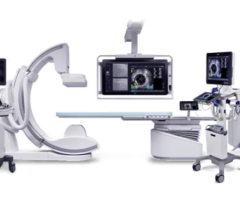December 20, 2012 — New streamlined guidelines will help healthcare providers better treat patients with the most severe type of heart attacks, according to an American Heart Association/American College of Cardiology statement.
The guidelines are published online in the American Heart Association journal Circulation and the Journal of the American College of Cardiology.
The new recommendations are for a type of heart attack known as ST-elevation myocardial infarction (STEMI), which occurs when a cholesterol plaque ruptures and a blood clot forms within an artery leading to the heart muscle, completely obstructing the flow of blood. A potentially large area of the heart may be affected by the resultant injury.
"Time is of the essence in the evaluation and treatment of these patients," said Patrick O'Gara, chair of the guidelines writing committee. "The sooner blood flow is restored, the better the chances for survival with intact heart function."
The most feared STEMI complications are the emergence of a lethal arrhythmia — a heart rhythm abnormality, which can lead to cardiac arrest — and heart failure as a result of the loss of a large amount of heart muscle. About 250,000 Americans suffer an ST-elevation MI each year.
The guidelines focus on clinical decision-making at all stages, beginning with the onset of symptoms at home or work, regional systems of care to ensure that patients get immediate treatment, and the rapid restoration of flow down the obstructed coronary artery.
Percutaneous coronary intervention (PCI), which comprises balloon angioplasty to open a clogged artery and stents to keep it open, is the preferred treatment strategy when it can be done quickly. When there are delays, as may occur when a patient arrives at a facility where intervention is not available, clot-busting drugs should be administered if safe for the individual patient, followed by transfer to a facility where intervention can subsequently be performed if needed.
Other key points in the new guidelines include:
- Improving patient recognition of heart attack symptoms and the importance of immediately calling 911. Patient delay in reporting symptoms is one of the greatest obstacles to timely and successful care. Travel by private car to the hospital is strongly discouraged.
- Recommending that emergency medical technicians perform electrocardiograms in the field to facilitate more rapid triage and speedier treatment.
- Using hypothermia (cooling) to treat patients who suffer cardiac arrest. To reduce brain injury in these patients, cooling protocols should be activated before or at the same time of cardiac catheterization.
- Providing care plans when the patient is discharged after STEMI, which are clearly communicated and shared with patients, families, and other healthcare providers. Referral for cardiac rehabilitation is a key factor. A table in the guidelines itemizes these considerations, including smoking cessation, cholesterol management, social needs, depression and cultural and gender-related factors that may contribute to outcomes.
"We're looking to a future where more patients survive with less heart damage and function well for years thereafter," said O'Gara, who is also the executive medical director of the Shapiro Cardiovascular Center and director of clinical cardiology at Brigham and Women's Hospital in Boston, Mass. "We hope the guidelines will clarify best practices for healthcare providers across the continuum of care of STEMI patients."
The guidelines were developed in collaboration with the American College of Emergency Physicians and the Society for Cardiovascular Angiography and Interventions.
More information on quick treatment for STEMI is on the Mission Lifeline website, where you can also find a map to locate STEMI systems of care.
For more information: www.newsroom.heart.org/pr/aha/_prv-new-guidelines-can-improve-treatment-241734.aspx


 December 20, 2023
December 20, 2023 








